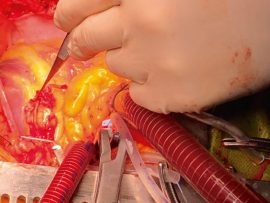Single coronary artery is a rare congenital anomaly with a quoted incidence of 0.024% to 0.06% (), and may be associated with sudden cardiac death after exercise and angina. We..
Lire la suiteSingle coronary artery is a rare congenital anomaly with a quoted incidence of 0.024% to 0.06% (), and may be associated with sudden cardiac death after exercise and angina. We..
Lire la suiteSingle coronary artery is a rare congenital anomaly with a quoted incidence of 0.024% to 0.06% (), and may be associated with sudden cardiac death after exercise and angina. We..
Lire la suiteSingle coronary artery is a rare congenital anomaly with a quoted incidence of 0.024% to 0.06% (), and may be associated with sudden cardiac death after exercise and angina. We..
Lire la suiteTransposition is the condition in which the great arteries take origin from the ventricles in reverse position across (“trans”) the ventricular septum: the aorta from the right ventricle and the..
Lire la suiteA sinus of valsalva aneurysm (SOVA) is an abnormal dilatation of the aortic root located between the aortic valve annulus and the sinotubular junction. It occurs as a consequence of..
Lire la suiteAneurysms of the sinus of Valsalva are extremely rare. Ruptured aneurysms of the sinus of Valsalva are frequently associated with other congenital defects, particularly with ventricular septal defect, aortic valve..
Lire la suiteCongenital heart diseases that cause obstruction of the right ventricular outflow tract are often difficult to diagnose. We report the case of a 49-year-old man who presented with long-standing shortness..
Lire la suiteCongenital heart diseases that cause obstruction of the right ventricular outflow tract are often difficult to diagnose. We report the case of a 49-year-old man who presented with long-standing shortness..
Lire la suitePartial anomalous pulmonary venous connection (PAPVC) is a rare congenital cardiac defect. As the name suggests, in PAPVC, the blood flow from a few of the pulmonary veins return to..
Lire la suiteBackground There is a high mortality in infants with right atrial isomerism (RAI). However, less is known about outcome in older children with RAI. This study sought to evaluate those..
Lire la suiteThe term “atrioventricular septal defect” (AVSD) covers a spectrum of congenital heart malformations characterised by a common atrioventricular junction coexisting with deficient atrioventricular septation. In ostium primum atrial septal defect..
Lire la suiteAbstract Background and Objectives Heparin-induced thrombocytopenia (HIT) is an antibody-mediated condition that leads to thrombocytopenia and possible thrombosis. Patients with HIT who require cardiac surgery pose a challenge as high..
Lire la suiteAbstract Postoperative coagulopathic bleeding is common in cardiac surgery and is associated with increased morbidity and mortality. Ideally, real-time information on in-vivo coagulation should be available. However, up to now..
Lire la suiteAbstract Objectives: Evaluating whether there is a clinical benefit of using extracorporeal cytokine adsorption therapy in two indications. Design: Systematic review. Setting: Search on four databases, Medline, Embase, The Cochrane..
Lire la suiteAbstract Objective Dysregulation of local nitric oxide (NO) synthetases occurs during and reperfusion associated with , (DHCA), and reperfusion. Rapid fluctuations in local occurring in neonates and infants probably contribute to inflammation-induced microglial activation..
Lire la suiteThis case reports on a 53-year-old female patient who was transferred from the isolation ward to the Medical Intensive Care Unit due to progressive respiratory deterioration in the context of..
Lire la suiteAbstract Cardioplegia is used to induce cardiac arrest in order to facilitate cardiac surgery in patients supported by cardiopulmonary bypass. It is administered directly into the coronary vessels after the..
Lire la suiteAbstract Background The effectiveness and safety of non-heparin anticoagulants for the treatment of heparin-induced thrombocytopenia (HIT) are not fully established, and the optimal treatment strategy is unknown. In a systematic..
Lire la suiteAbstract Purpose: Purpose: Condensation that clogs the hollow fibers of the oxygenation and accumulation of plasma leaks reduces oxygenated lung capacity. In this study, artificial We evaluated whether monitoring changes..
Lire la suiteAbstract Introduction: The contribution of fluid temperature to the effect of crystalloid fluid bolus therapy (FBT) in post-cardiac surgery patients is unknown. We evaluated the hemodynamic effects of FBT with..
Lire la suiteAbstract Background Several aquatic organisms such as loaches have evolved unique intestinal breathing mechanisms to survive under extensive hypoxia. To date, it is highly controversial whether such capability can be..
Lire la suiteAbstract Objective Timing and causes of hospital mortality in adult patients undergoing veno-arterial extracorporeal membrane oxygenation (V-A ECMO) have been poorly described. Aim of the current review was to investigate..
Lire la suiteAbstract Objectives: Cardiac surgery using cardiopulmonary bypass frequently provokes a systemic inflammatory response syndrome. This can lead to the development of low cardiac output syndrome (LCOS). Both of these can..
Lire la suiteAbstract Introduction Cardiopulmonary bypass (CPB) is a common procedure to maintain body perfusion during cardiac surgery. It is associated with a systemic inflammatory response, hemostasis and circulatory dysfunction that can..
Lire la suiteAbstract Background: Due to the substantial improvement in survival among pediatric patients undergoing congenital heart surgery, reducing early and long-term morbidity is becoming the major focus of care. Blood transfusion is..
Lire la suiteAbstract The outbreak of the novel coronavirus pandemic (COVID-19) has resulted in dramatic changes to the conduct of surgery both from a patient management perspective and in protecting healthcare providers...
Lire la suiteAbstract Background We sought to determine differences in the circulating metabolic profile of infants with or without acute kidney injury (AKI) following cardiothoracic surgery with cardiopulmonary bypass (CPB). Methods We..
Lire la suiteAbstract Background Cerebral autoregulation mechanisms help maintain adequate cerebral blood flow (CBF) despite changes in cerebral perfusion pressure. Impairment of cerebral autoregulation, during and after cardiopulmonary bypass (CPB), may increase..
Lire la suite

























